The Field of Light
Richard and Cecilia Twinch pay a visit to Bruce Munro’s extraordinary art installation at Uluru
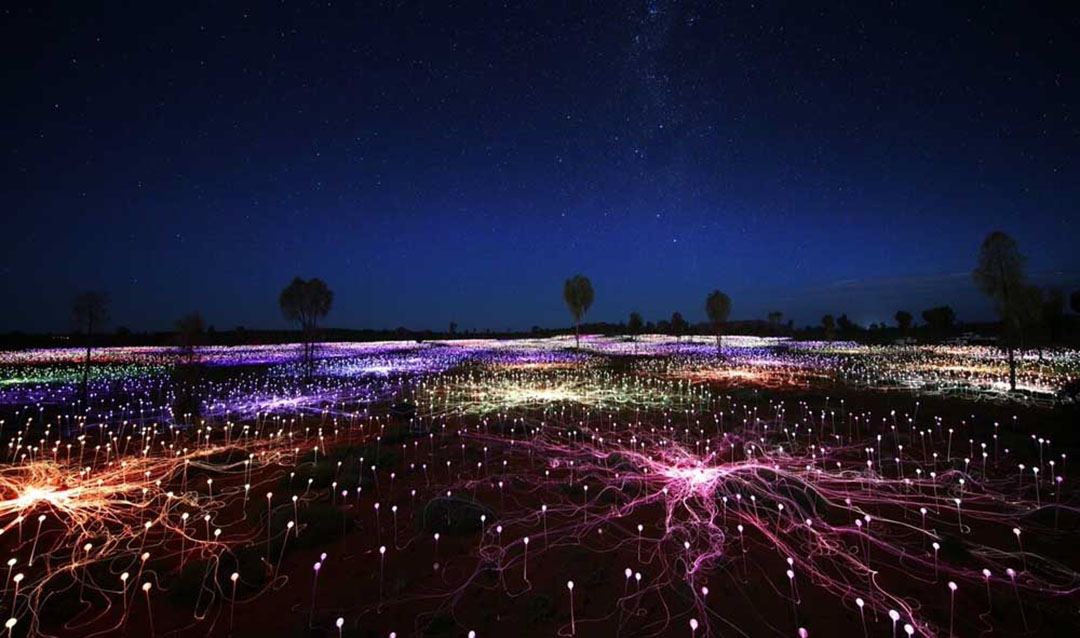
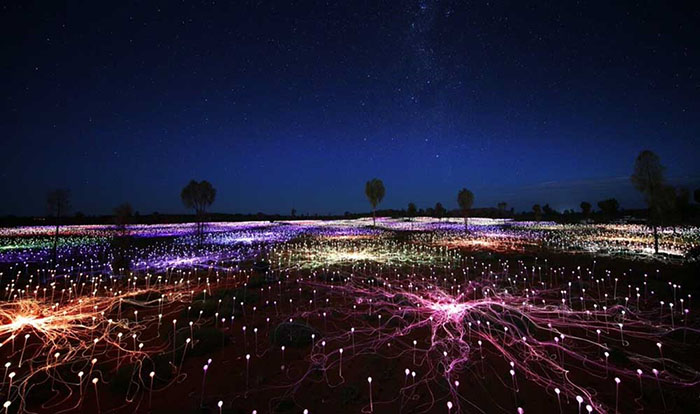
The Field of Light
Richard and Cecilia Twinch pay a visit to Bruce Munro’s new installation at Uluru
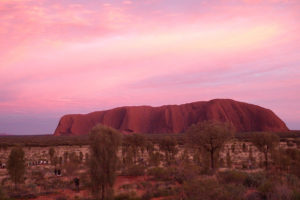 Global unitative experiences that are open to all, whatever creed or background people may have, are rare events these days. There are still many centres of religious pilgrimage that attract hundreds of thousands and, in some cases, millions of people, such as Mecca and Mount Athos. They offer a unitive experience within a religious framework, which nevertheless tends to exclude those who are not followers. For many people the direct experience of nature and appreciation of art have taken the place of religion, as evidenced by the millions who flock to art galleries and National Parks rather than to the temple, church or mosque.
Global unitative experiences that are open to all, whatever creed or background people may have, are rare events these days. There are still many centres of religious pilgrimage that attract hundreds of thousands and, in some cases, millions of people, such as Mecca and Mount Athos. They offer a unitive experience within a religious framework, which nevertheless tends to exclude those who are not followers. For many people the direct experience of nature and appreciation of art have taken the place of religion, as evidenced by the millions who flock to art galleries and National Parks rather than to the temple, church or mosque.
On a recent trip round Australia, we were lucky enough to stumble upon a rare conjunction of nature, culture and art in one event. On the 1st April – some two weeks before we visited the sacred site of Uluru (formally known as Ayers Rock) in the Northern Territory of central Australia – the Field of Light had spread its wings on the plain in front of the Rock. This is the result of a concept which formed in the mind of the British artist Bruce Munro in 1992 when he camped (as one could do then) adjacent to the Rock and experienced the qualities of natural light and landscape, as well as the force and energy of the place. He says of this inspiration that he wanted “to express that feeling of joy, a mixture of joy and serenity”:
The Field of Light installation was one idea that landed in my sketchbook and kept on nagging me to be done. I saw in my mind a landscape of illuminated stems that, like a dormant seed in a dry desert, quietly wait until darkness falls, under a blazing blanket of southern stars, to bloom with gentle rhythms of light.
Light has been a passion of Munro’s following an experience that he had as a small boy: “When I was about eight walking from my father’s house into Salcombe and thinking: ‘When is the secret going to be revealed?’ Because I thought there was an essence which was mysterious.” Later, as he describes in his book Catching the Light, he experienced an unveiling of unity:
At the age of twenty-one, I was running down a path at home and smelling wild apricots on a beautiful autumn evening. Then I disappeared and felt as if I were floating across the ground. It was a magic moment, being at one with the world.
Having conceived of a field of light at Uluru, Munro (then aged thirty-three) went on to explore it in a number of his installations: first at his home in Wiltshire in the UK in 2004, with the help of family and friends, and in the same year at the Victoria and Albert Museum; then in 2005 at the Eden Project and in venues in the United States. The current Field is the result of thousands of hours of work and years of planning, and it is the first of his installations to rely entirely on solar energy.
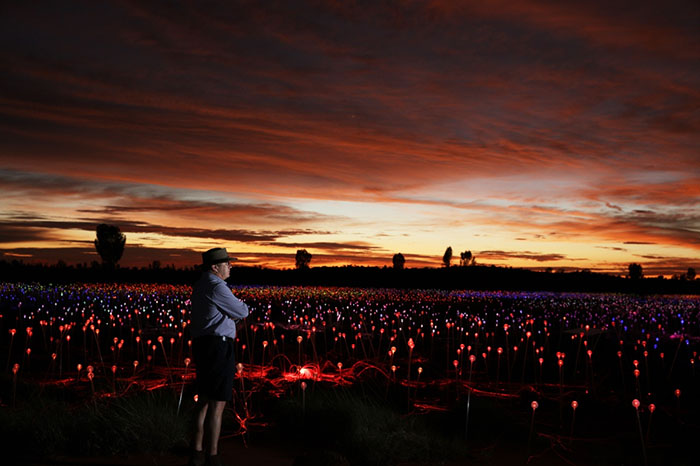
Uluru – or Ayers Rock as it was named in 1873 after Sir Henry Ayers – is the centre of the homeland of the Anangu, an indigenous Australian people who have lived there for thousands of years. They hold the land sacred; every feature is seen as the result of the activities of supra animal-human ancestors who defined the land through their actions at the creation – or ‘dream-time’ – which for the Aboriginals is both past and present. Our favourite myth is the story surrounding the waterhole Kapi Mutitjulu on the east side of the Rock, where Kuniya, the Python Woman, battled with Wati Liru (Poisonous Snake Man) who had mortally wounded her nephew Kuka Kuka. After the great conflict, presaged by a special power-giving dance (called ‘akuta’ which is a dance step women use when they want to fight), and the subsequent death of the Liru man, both Kuniya and her nephew were transformed into Wanampi, or rainbow snakes, inhabiting the gorge above the waterhole which carries their name. This is now a place of great peace and beauty, where their story is written in the stones, incisions and folds in the rock and is passed on from generation to generation, from grandparents to grandchildren.
We found it particularly interesting that the error of Wati Liru man was not the spear thrust itself (Kuka Kuka had after all offended him) but the subsequent abandonment of the wounded man. In aboriginal culture, a wounded man should be looked after by the person who has wounded him until he has recovered sufficiently to look after himself. This is a profound wisdom which has continuing relevance in the present day; long term damage is not just the result of a spear throw.
Geologists have an alternative story as to how the great monolith of Uluru was formed in geological time, which is also fascinating.
Uluru/Ayers Rock, as it is officially known, is now owned by the Anangu after a fierce legal battle, and leased back to the Australian government who maintain it, with the Aboriginals, as a National Park. It is a World Heritage Site and one of the world’s great natural icons, along with the Grand Canyon and Mount Everest, which are held in similar veneration by their own indigenous peoples.
On our visit, we were taken to view the sunset over Uluru from a new vantage point overlooking the red desert (bush) that stretched between us and the Rock. From there we watched as the sun set and the stars gradually appeared, whilst at our feet the Field of Light started to come alive in the desert as far as the eye could see. It covers a huge area of 49,000 square metres (12 acres); witnessing the vastness of the space, Munro said on his return to Australia some twenty years later: “There is no point in doing it unless we do it properly – it’s got to be a certain scale to work with the space.”
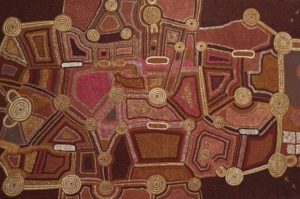 Munro was concerned not to upset the Aboriginal people and to be in harmony with the people and the land. So we were glad to hear that the Anangu are very happy with the installation that they have allowed to be set on their private land and which they call Tili Wiru Tjuta Nyakutjaku or “looking at lots of beautiful lights”. And beautiful lights they were as 50,000 of them gradually woke up, reminding us of the Aboriginal dot paintings we had just seen in the art galleries of Melbourne and Adelaide.
Munro was concerned not to upset the Aboriginal people and to be in harmony with the people and the land. So we were glad to hear that the Anangu are very happy with the installation that they have allowed to be set on their private land and which they call Tili Wiru Tjuta Nyakutjaku or “looking at lots of beautiful lights”. And beautiful lights they were as 50,000 of them gradually woke up, reminding us of the Aboriginal dot paintings we had just seen in the art galleries of Melbourne and Adelaide.
We were then free to descend from our vantage point and wander through this great spectacle, which, from ground level, stretches out in all directions with the looming shape of Uluru under the half-moon still reminding us of its considerable presence. The spheres are stemmed like tulips, and the colours appear in patches of white, vivid reds, deep blues and greens – a magnificent garden, fulfilling Munro’s original concept, which he has described as “imagining lights flowering in the desert, as if nourished by a miraculous shower of rain”. The intensity of the light has been toned down so as not to compete with the stars, as Munro wanted to create a balance rather than a conflict.
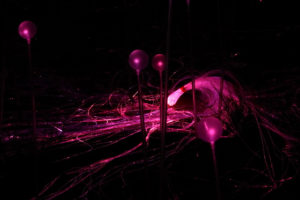 We discovered that the fibre optic cables linking these illuminated glass spheres themselves glowed, with coloured light being pulsed through the system. And then, standing still, we noticed that the colours were changing, slowly and almost imperceptibly. (We mentioned this to one of our fellow ‘field-farers’ and he told us that his son, who is slightly autistic, had noticed this straight away.) Suddenly it was as if we were standing in the centre of a huge brain, with the lights like neurons, seemingly responding to each other, as ‘thoughts’ and ‘emotions’ flooded through the system, connecting to a great field of energy that flowed all around and included us.
We discovered that the fibre optic cables linking these illuminated glass spheres themselves glowed, with coloured light being pulsed through the system. And then, standing still, we noticed that the colours were changing, slowly and almost imperceptibly. (We mentioned this to one of our fellow ‘field-farers’ and he told us that his son, who is slightly autistic, had noticed this straight away.) Suddenly it was as if we were standing in the centre of a huge brain, with the lights like neurons, seemingly responding to each other, as ‘thoughts’ and ‘emotions’ flooded through the system, connecting to a great field of energy that flowed all around and included us.
The sky was clear for the first time in several days and the stars by this time had joined in overhead, so we were illuminated from above and below. Venus shone brightly near the moon, and the Southern Cross was clearly visible against the Milky Way. We wondered: had we entered paradise? Were we still alive or had we died?
Our time was up all too soon, and we were summoned to return to more mortal realms, allowing others their glimpse of this ‘paradise on earth’. But as we turned, the heavens had one last trick. A huge shooting star streaked vertically down the night sky and then exploded with a great flash but no sound. Having just seen similar pictures of the meteor in New England on 3rd May, it was clear to us that this was another large meteor breaking up somewhere in the vastness over central Australia.
So, thanks to the imagination and persistence of Bruce Munro, we were lucky to experience at first hand the ‘coming home’ of this great concept, and to participate fully in a truly unitive experience where imagination, concept, culture, the natural landscape and even the universe itself all join in a great celebration of wonder and beauty as pure light.
The Field of Light is still open at Uluru, and will be for the
NEVER MISS AN ARTICLE
Please follow and like us:
CATEGORIES
Email this page to a friend
Email this page to a friend
Image Sources
Banner: Field of Light, Uluru, Bruce Munro 2016. Photo by Mark Pickthall
If you enjoyed reading this article, please leave a comment below.
Please also consider making a donation to support the work of Beshara Magazine. The magazine relies entirely on voluntary support. Donations received through this website go towards editorial expenses, eg. image rights, travel expenses, and website maintenance and development costs.
Please follow and like us:
READ MORE IN BESHARA MAGAZINE:

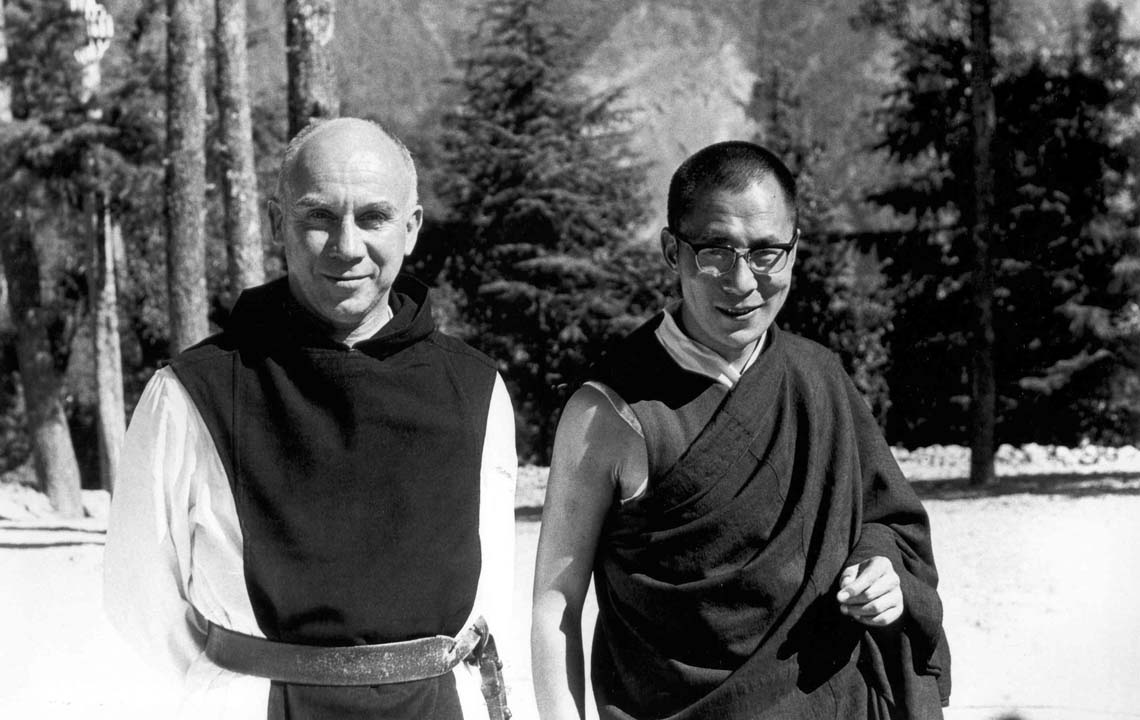
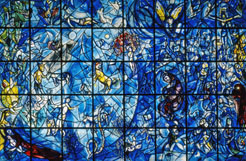
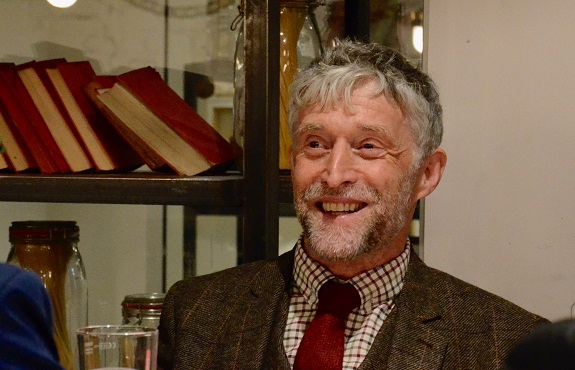
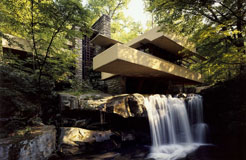
1